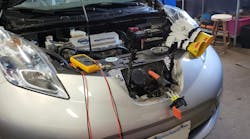With growing interest in fuel economy, more vehicle manufacturers are incorporating stop/start technology that conserves energy by shutting off the engine when the vehicle is at rest, and automatically re-starting it when the driver pushes the gas pedal to go forward. As more vehicles have this feature, aftermarket service providers need to know how to diagnose problems associated with this technology, which is more complex than traditional starter systems.
The good news for the automotive aftermarket, according to a session on start/stop technology during the Automotive Aftermarket Products Expo (AAPEX) held in Las Vegas, is that changing the battery will require a professional. The seminar, titled “start/stop technology, it’s coming your way,” drew a standing-room-only turnout at the Sands Expo Center in Las Vegas during AAPEX.
Michael Loth, director of technical services and support groups at Robert Bosch LLC, began the presentation noting that start/stop technology has been common in European vehicles since 2007. At present time, he said more than half of new European vehicles have this technology. By 2019, he said, it is predicted that 40 percent of all new cars will have start/stop technology.
Loth said start/stop technology provides up to 12% savings in fuel costs and 8% carbon dioxide emission reduction.
The start/stop function is controlled by the vehicle’s battery system, Loth noted. “It’s going to be more and more important to maintain batteries,” he said.
He noted that stop/starter technology requires absorbed glass mat (AGM) batteries, which have more power per weight than lead acid batteries. He said scan tools are needed when changing AGM batteries, and because of this, he said it will no longer be possible for car owners to change their own batteries.
He noted that with these systems, starters have been redesigned and have longer lifetimes.
The start/stop system is controlled by the car’s electronic control unit (ECU), Loth said.
In response to a question from the audience, Loth noted that his company has no plans at the present time to make aftermarket stop/starter systems, but he expects aftermarket systems to eventually become available.


